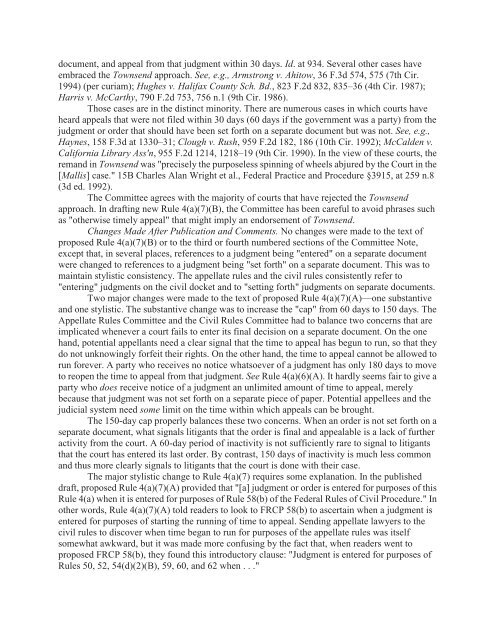Federal Rules of Appellate Procedure 2014-2015, 2014a
Federal Rules of Appellate Procedure 2014-2015, 2014a
Federal Rules of Appellate Procedure 2014-2015, 2014a
You also want an ePaper? Increase the reach of your titles
YUMPU automatically turns print PDFs into web optimized ePapers that Google loves.
document, and appeal from that judgment within 30 days. Id. at 934. Several other cases have<br />
embraced the Townsend approach. See, e.g., Armstrong v. Ahitow, 36 F.3d 574, 575 (7th Cir.<br />
1994) (per curiam); Hughes v. Halifax County Sch. Bd., 823 F.2d 832, 835–36 (4th Cir. 1987);<br />
Harris v. McCarthy, 790 F.2d 753, 756 n.1 (9th Cir. 1986).<br />
Those cases are in the distinct minority. There are numerous cases in which courts have<br />
heard appeals that were not filed within 30 days (60 days if the government was a party) from the<br />
judgment or order that should have been set forth on a separate document but was not. See, e.g.,<br />
Haynes, 158 F.3d at 1330–31; Clough v. Rush, 959 F.2d 182, 186 (10th Cir. 1992); McCalden v.<br />
California Library Ass'n, 955 F.2d 1214, 1218–19 (9th Cir. 1990). In the view <strong>of</strong> these courts, the<br />
remand in Townsend was "precisely the purposeless spinning <strong>of</strong> wheels abjured by the Court in the<br />
[Mallis] case." 15B Charles Alan Wright et al., <strong>Federal</strong> Practice and <strong>Procedure</strong> §3915, at 259 n.8<br />
(3d ed. 1992).<br />
The Committee agrees with the majority <strong>of</strong> courts that have rejected the Townsend<br />
approach. In drafting new Rule 4(a)(7)(B), the Committee has been careful to avoid phrases such<br />
as "otherwise timely appeal" that might imply an endorsement <strong>of</strong> Townsend.<br />
Changes Made After Publication and Comments. No changes were made to the text <strong>of</strong><br />
proposed Rule 4(a)(7)(B) or to the third or fourth numbered sections <strong>of</strong> the Committee Note,<br />
except that, in several places, references to a judgment being "entered" on a separate document<br />
were changed to references to a judgment being "set forth" on a separate document. This was to<br />
maintain stylistic consistency. The appellate rules and the civil rules consistently refer to<br />
"entering" judgments on the civil docket and to "setting forth" judgments on separate documents.<br />
Two major changes were made to the text <strong>of</strong> proposed Rule 4(a)(7)(A)—one substantive<br />
and one stylistic. The substantive change was to increase the "cap" from 60 days to 150 days. The<br />
<strong>Appellate</strong> <strong>Rules</strong> Committee and the Civil <strong>Rules</strong> Committee had to balance two concerns that are<br />
implicated whenever a court fails to enter its final decision on a separate document. On the one<br />
hand, potential appellants need a clear signal that the time to appeal has begun to run, so that they<br />
do not unknowingly forfeit their rights. On the other hand, the time to appeal cannot be allowed to<br />
run forever. A party who receives no notice whatsoever <strong>of</strong> a judgment has only 180 days to move<br />
to reopen the time to appeal from that judgment. See Rule 4(a)(6)(A). It hardly seems fair to give a<br />
party who does receive notice <strong>of</strong> a judgment an unlimited amount <strong>of</strong> time to appeal, merely<br />
because that judgment was not set forth on a separate piece <strong>of</strong> paper. Potential appellees and the<br />
judicial system need some limit on the time within which appeals can be brought.<br />
The 150-day cap properly balances these two concerns. When an order is not set forth on a<br />
separate document, what signals litigants that the order is final and appealable is a lack <strong>of</strong> further<br />
activity from the court. A 60-day period <strong>of</strong> inactivity is not sufficiently rare to signal to litigants<br />
that the court has entered its last order. By contrast, 150 days <strong>of</strong> inactivity is much less common<br />
and thus more clearly signals to litigants that the court is done with their case.<br />
The major stylistic change to Rule 4(a)(7) requires some explanation. In the published<br />
draft, proposed Rule 4(a)(7)(A) provided that "[a] judgment or order is entered for purposes <strong>of</strong> this<br />
Rule 4(a) when it is entered for purposes <strong>of</strong> Rule 58(b) <strong>of</strong> the <strong>Federal</strong> <strong>Rules</strong> <strong>of</strong> Civil <strong>Procedure</strong>." In<br />
other words, Rule 4(a)(7)(A) told readers to look to FRCP 58(b) to ascertain when a judgment is<br />
entered for purposes <strong>of</strong> starting the running <strong>of</strong> time to appeal. Sending appellate lawyers to the<br />
civil rules to discover when time began to run for purposes <strong>of</strong> the appellate rules was itself<br />
somewhat awkward, but it was made more confusing by the fact that, when readers went to<br />
proposed FRCP 58(b), they found this introductory clause: "Judgment is entered for purposes <strong>of</strong><br />
<strong>Rules</strong> 50, 52, 54(d)(2)(B), 59, 60, and 62 when . . ."


















